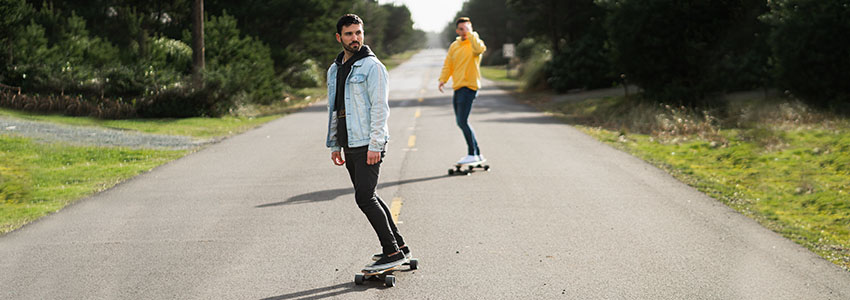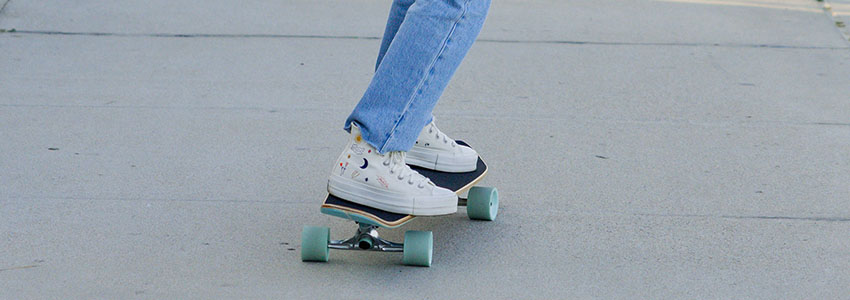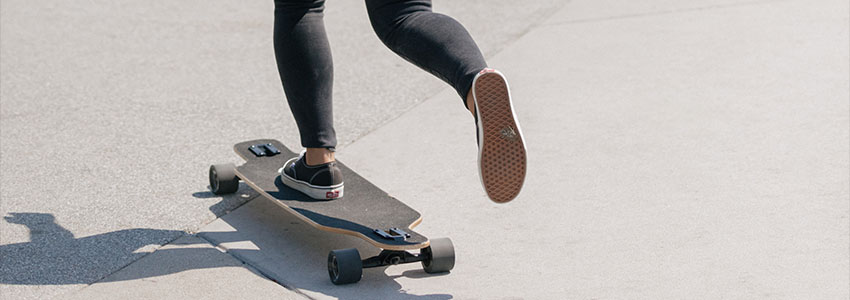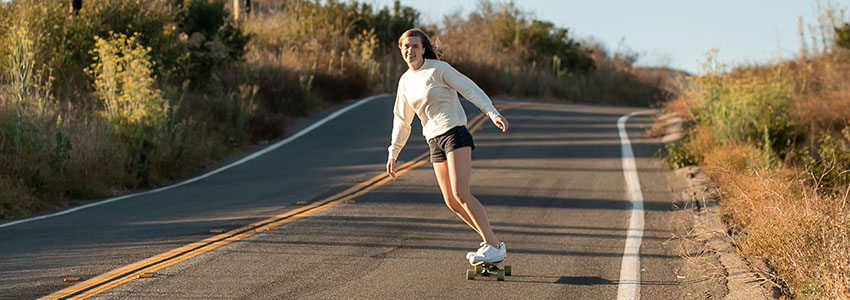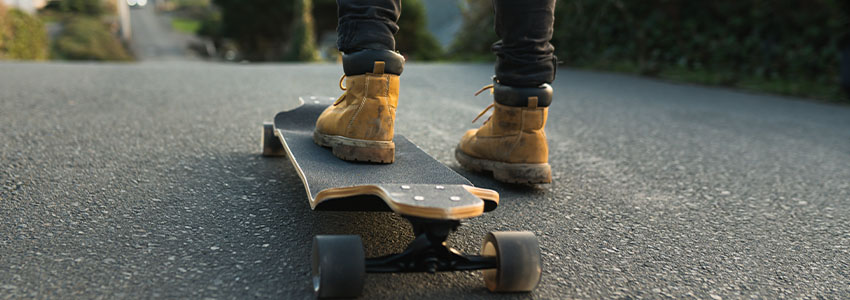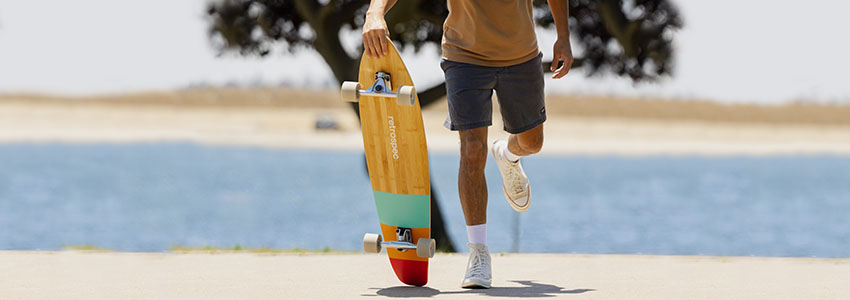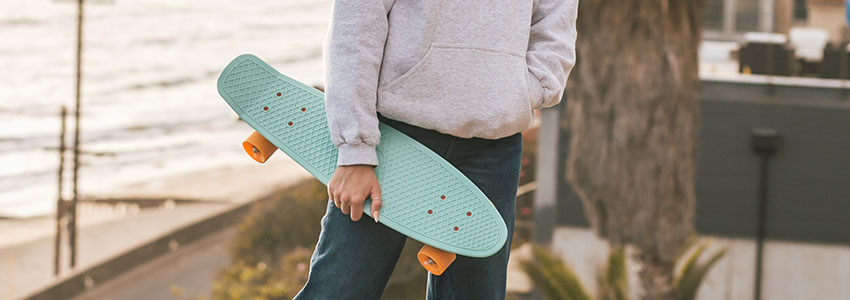How to Skateboard: 5 Steps for Beginners
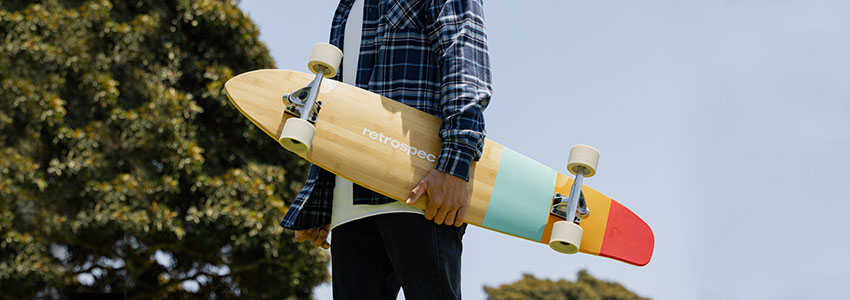
What began as kids riding milk crates with wheels in the 1930s has become one of the most popular and accessible sports in the world.
People everywhere from Kenya to Kathmandu to Kentucky all ride skateboards, but skateboarding remains an intimate, tight-knit community.
Whether or not you’re just starting skateboarding, cruising to class on a longboard or dropping into bowls at the local skatepark…welcome to the skate community!
Today, we’ll teach you how to skateboard in five simple steps.
Is Skateboarding Dangerous?
Skateboarding can seem daunting to a newbie.
Even though it’s possible to get injured while skating, your chances are lowered if you wear proper protective gear, like a helmet.
In the US, around 100,000 skaters are treated for injuries in emergency rooms each year.
However, you might be surprised to know that skating is actually much safer than many popular sports like football and soccer, where contact and collision are a normal part of gameplay.
A Comprehensive Study of Sports Injuries in the U.S. found that many sports such as basketball, running, football, baseball and others have a higher rate of injury than skateboarding.
That said, head injuries are still more common in skating than in many other sports, so wearing a helmet is essential, particularly while learning.
Other protective gear, like elbow and kneepads, as well as proper footwear, can further prevent skating injuries.
Where to Learn to Skate
Try to practice on a smooth, flat surface.
An empty parking lot, parking garage, or sidewalk can make for great learning ground. Avoid inclines and any location with cracks, rocks, or other obstructions.
Skateparks can be a good place to learn, but only if there isn’t anyone else around, as they can be crowded and chaotic, with varied terrains, obstacles, and ramps.
As a beginner, you may inadvertently get in the way of other riders, so it’s best to master the basics on flat, open ground before you head to a skatepark.
Find Your Stance
Like surfing, snowboarding, or any other “board” sport, skateboarders all use one of two stances: Regular or Goofy.
This stance is determined by which foot you put in the front of the board.
Regular means you feel more comfortable with your left foot in front. Most skaters are regular-footed (hence the name).
Goofy means you feel more comfortable with your right foot in front.
There’s no right or wrong stance, just stand on your skateboard and feel what stance is most instinctive and comfortable.
1. How to Stand on a Skateboard
Standing on your skateboard is the first step.
If it helps, you can place your board on a patch of grass to keep it from rolling while you try to stand on it.
Step onto the board one foot at a time, starting with your front foot, and stand with your feet perpendicular to the board, shoulder-width apart.
While learning, both feet should be positioned over the bolts that attach the trucks to the board, which provides optimal stability and balance.
Point your head and torso ahead in the direction you want to go, and practice balancing, shifting your weight slightly from front to back foot.
Keep your knees bent and loose at all times.
As you advance, this will help you prepare for tricks, but it will also keep you dynamic and fluid as you’re riding, giving you a lower center of gravity and balance.
Once you feel balanced on the board, practice stepping off and on.
Next, you can practice standing on the board with only your front foot, balancing with your back foot in the air, slightly off and away from the board. This will help you prepare for the next step: Pushing.
2. How to Push on a Skateboard
Pushing properly is essential if you want to learn how to skate. If you aren’t pushing right, you won’t go very far.
To push, you’ll need to pivot your front foot slightly (about 30°) so that it’s no longer pointing sideways and is pointing slightly forwards.
Then, step off the board with your back foot, balancing your weight on your front foot. Push with your back foot, driving the board forward.
Now put your back foot back on the board. If you’re going to be coasting for a while, you can return your front foot to its 90° (sideways) angle. If you’re going to push again, keep that front foot pivoted and repeat the motion.
3. How to Turn on a Skateboard
Carve turns and kick turns are two basic ways to turn on a board.
Carve turns involve leaning to one side or the other, allowing your trucks to turn your board (without the wheels coming off the ground). Carving comes naturally the more you practice.
Here’s how you do it:
Bend your knees and get low before leaning into your turn.
Lead with your upper body, pointing your head and shoulders in the direction you want to go, and apply pressure with either your toes (frontside) or heels (backside) in the direction you’re turning.
TIP: The tightness of your trucks will determine your carving ability.
Tighter trucks provide more stability but limit your carving.
Looser trucks allow for easier carving but are much less stable.
Generally, a beginner skater should have tighter trucks, then loosen them as they get more comfortable.
Kick turns let you pivot the board sharply at slow speeds, making them great for navigating around obstacles or switching directions.
These turns are a bit more difficult, requiring you to bring the front wheels of the board off the ground. As you progress, you can also use rapid kick turns in quick succession to pick up speed.
To kick turn, put your back foot on the tail of the board and lean back slightly, applying pressure to lift the front wheels into the air.
Then, rotate the nose (front) of the board in the direction you wish to turn, again leading with your head, shoulders, and hips.
Once the nose of the board is pointed in the direction you want to go, drop the front of the board and push away.
4. How to Stop on a Skateboard
Repeated carving will slow you down, but if you want to completely stop, or slow down rapidly, you need to master foot braking.
Foot braking is fairly simple.
It involves dragging your foot on the ground, using the bottom of your shoe to slow the board.
Just like when pushing, balance your weight over your front foot, and drop your back foot onto the ground.
Instead of pushing down on the ground, drag the sole of your shoe over the pavement, keeping most of your weight over the board, and use the friction from your shoe to slow down.
Once your board is slow enough, you can fully put your foot down to stop.
Once you master normal foot braking, you can also brake without fully removing your back foot from the board.
Simply slip your back foot forward to the edge of the board, then drop your toe and forefoot off the board and onto the ground, using the front half of your shoe to apply pressure and brake while keeping the rest of the shoe on the board.
TIP: Don’t put your full weight on the ground when foot braking—this will throw you off balance.
Gently place your foot down, keeping most of your weight still on the board, and only apply enough friction to slow yourself down.
If you do sense that you’re going to get thrown off your board, it’s important to know how to fall properly.
Many skaters will keep their elbows and head tucked while they roll onto their backs or stomachs.
5. How to Throw Down Your Skateboard
If you’re using a longboard, you won’t need to throw down your board, but if you’re using a traditional skateboard or a cruiser, throwing down your board before you hop on can get you started with a bit of momentum.
Grab the nose of the board with your leading arm (the one on the same side as your front foot), and take a step forward with your opposite foot (back foot).
Hang the board in front of your front leg, and drop it as you step forward.
Then, place your front foot into position on the board as it lands.
The motion itself is fairly simple, but the process is trickier than it sounds.
Learning to throw down your board and hop on will take time.
While it’s not a necessary skill, it’s just something that can make hopping on your board more efficient.
Keep at it, and soon it’ll feel like second nature.
Types of Skateboarding
Back in the 80s, skateboarding was just… skateboarding. Four wheels, trucks, a deck, and you were off. Nowadays, there are several different types of skateboarding.
Longboarding
Longboards are longer and wider than traditional skateboards, and feature both larger and softer wheels, so they’re more stable and have more traction.
Longboarding is great for commuting around town, reaching high speeds, or bombing big hills, but isn’t great for learning trxicks.
These boards are typically heavy and bulky, so it’s almost impossible to get them off the ground.
However, longboards are a great intro to skating since they’re much larger and more stable than traditional skateboards.
Trick Skating
Trick skating is a large category that includes a variety of skating styles.
Basic tricks like, “vert” (“vertical”) skating involves dropping into bowls or ramps, moving from a “horizontal” to a “vertical” plane to perform tricks.
Street skating involves skating in urban environments, performing tricks on and around rails, ramps, stairs, and other urban obstacles.
Park skating is similar to street skating but involves skating in a skatepark instead of an open urban environment.
Freestyle skating, one of the oldest types of skateboarding, involves performing tricks like tic tacs on flat ground, often with music and choreography.
In short, these are the traditional “skateboarding” categories, focused on using the board to perform tricks. For trick skating, you’ll want a normal skateboard.
Cruising
Cruising is a mix of longboarding and trick skating.
You’re using a smaller, lighter board, but you’re “cruising,”—riding for a long period without stopping.
Cruiser boards are great for getting to class or work, running errands, or just riding around town and relaxing.
They’re lighter and smaller than longboards, so they’re easier to stash in a backpack or carry around in your hand, but they offer softer, larger wheels and more stability than normal skateboards.
Learning to ride on a cruiser is a great way to start skating.
Extra Skateboarding Pro Tips
Skating has a unique culture, and there are a few Do’s and Don’ts you should know before you get started.
Wear Gear
There’s nothing cool about getting hurt.
While it might seem stylish to leave the helmet and knee pads at home, gear can protect you from serious injury.
If you’ve been skating for years, maybe you’ll want to ditch the gear every now and then, but especially while you’re learning, there’s no reason not to pad up.
Even Tony Hawk is rarely seen without a helmet. Snag some protective gear!
Skate shoes are also a must. With a flat, polyurethane sole, they are optimally designed to skate with ease and control.
Don’t Mall Grab
Even though it might seem natural to hold your board by the front trucks, with the inside of the board against your leg, avoid doing it.
This is called “mall grabbing,” and it’s a major no-no in skating.
For starters, most veteran skaters just don’t see this as an acceptable way to hold a skateboard. It’s simply “uncool”.
Mall grabbing is also bad for technical reasons though.
Trucks are greasy and will get gunk on your hands, and walking with the grip tape rubbing against your pants or shorts will damage them over time.
Instead, tuck your board under your arm, or hold it by the nose, not the trucks.
Don’t Push Mongo
Pushing “mongo,” or pushing with your front foot instead of your back foot, is also bad form when skating.
Some experienced skaters still push mongo, but when you’re learning, avoid it at all costs. It might feel more natural, but it’s a bad habit to get into.
Pushing mongo changes everything about skating, putting your weight onto your back foot instead of your front foot on the board. This makes setting up for tricks extremely hard.
You’re also naturally more off-balance when riding, and you’ll even have a harder time turning when your foot is off the board pushing, since your weight will be at the back of the board, not the front.
When you turn a bike, you turn with the front wheel, right? Same concept.
Keep that front foot on the board.



